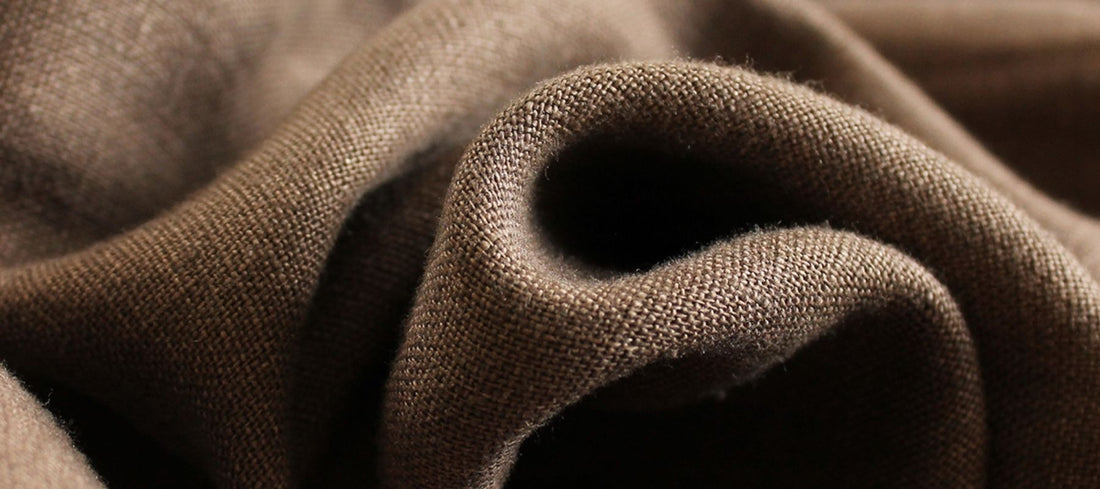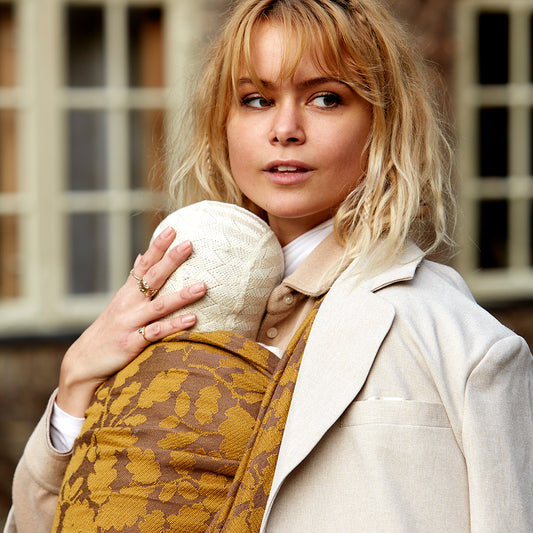GSM is all about weight
In the world of wrapping, however, the abbreviation "GSM" is often encountered. GSM is an abbreviation of "Grams per Square Meter", in Danish "grams per square meter". Sometimes it is referred to as gsm, or g/m2. It is a term for the weight of fabric. A GSM of 200 simply means that one square meter of the fabric in the wrap/sling weighs 200 grams.
A myth about carrying capacity
GSM, often misunderstood, is mistakenly referred to as "weight-bearing capacity." Sometimes, you might hear that a wrap should ideally have a high GSM for comfortable carrying of heavier children. However, GSM solely indicates the fabric's weight and doesn't provide any information about its carrying characteristics. The belief that a high GSM is necessary in a woven wrap or sling for comfortable carrying of larger children is indeed a misconception.
Carrying comfort
GSM can only provide a rough indication of a wrap's thickness. The comfort of wearing a woven wrap or sling depends largely on the weaving technique, the type of fibers used, and the density of the threads. The wrap's pattern and how the threads are spun also play a role. For optimal comfort, achieving a proper and tight wrap job is crucial.
Indeed, the tightness of the wrap job is of great importance. The wrap should distribute the child's weight comfortably and evenly across the wearer's back, shoulders, and hips.
Low GSM
Low GSM, in the right blend and weave, can carry heavy children well.
Thinner wraps are easier to tighten correctly, ensuring even and comfortable weight distribution. Airy fibers like merino wool are very lightweight in relation to their strength - at the same time, wool fibers have great strength and high carrying comfort, as the airy fibers provide a cushioned feeling on the shoulders - commonly referred to as "cush". Hemp is another fiber that, even though the fiber itself is not particularly light, can be woven thinly without compromising carrying capacity. This is because hemp is incredibly strong and doesn't stretch much in length. A thin wrap or ring sling made with hemp can thus provide very firm support that is easy to evenly distribute since the fabric is not very thick.
The thicker the wrap, the more challenging it can be to tighten it correctly. A thick and heavy wrap will - all else being equal - also be warmer to wear than a thinner, lighter wrap.
High GSM
However, it's not the case that lightweight wraps are always the solution. A substantial and thicker wrap can also be the right choice for you - it's largely a matter of personal preference. A wrap with a high GSM is not necessarily unsuitable for small babies either.
High GSM, in the right blend and weave, can carry small babies well.
Some fibers contribute to a higher weight. These could include silk, nylon, or milk fiber, all of which are heavy fibers. A wrap can also be woven more densely with thicker threads or in a double layer. A heavier wrap that is still loosely woven with soft fibers can easily wrap around a smaller child.
Weight is not crucial, then, if you're trying to assess how a wrap will perform.
Blend matters
As mentioned, fibers themselves can be heavy or lightweight, cushy or firm, grippy or smooth, and often a wrap is composed of a combination of different types of fibers. Additionally, threads can be thin or thick, or spun in different ways that make their surface uneven. There are many different types of specialty threads (such as chenille or bouclé). Other types of threads are spun tightly and are smooth. All of these factors influence the carrying properties of a wrap.
The weave matters
A significant factor in the carrying characteristics of a wrap is how the fabric is woven. This is why wraps are woven in a specific manner that is quite different from the way fabric for curtains or clothing is typically woven. Wraps are often loosely woven to provide the diagonal stretch that allows it to mold to the body. However, there is also variation in this aspect. The tighter the weave, the more firm support the fabric will provide. But a firm and stable weave compromises the diagonal stretch, so wraps of the same blend and weight cannot be directly compared if the weave or pattern is different. Wraps that share the same blend, pattern, and weave can be compared, but otherwise, they cannot be easily compared.
Other factors
And finally, there's the softness and suppleness of the fibers in the fabric, both as they are initially and as they become with use. There's also a lot of variation in this aspect, even within the same type of fiber. Wool, cotton, and linen can vary significantly in their initial softness.
How to choose your wrap
I apologize if I'm not exactly making the process of choosing the right wrap clearer. However, for a moment, forget about GSM, blend, weaving, etc., and instead focus on how the seller or retailer describes the properties of the wrap.
If they advise against it, for instance, for beginners, then be extra attentive. Often, a seller aims to appeal to a wide range of customers. Take a step back if the wrap you had in mind for your newborn is described as a "toddler prison recommended for experienced wrappers." Conversely, a wrap described as beginner-friendly can certainly be suitable even for experienced wrappers and for older children.
Even though a seller wants to cast a wide net in describing the wrap, it's been my experience that most reputable manufacturers and retailers honestly describe the attributes of their products. No one wants disappointed customers - quite the opposite!
Try if you can
Den bedste vurdering af en vikle, får du ved at prøve den på. Det kan dog være lettere sagt end gjort. Nogle producenter afholder grams eller pop-op events. Andre har deres vikler til salg ved forhandlere med fysiske butikker. Mange private afholder også "grams" - private begivenheder hvor man mødes og prøver hinandens vikler. Måske er du heldig, at en deltager har netop den vikle du har kig på.
Use the experiences of others
If you can't try the wrap yourself, you can consider looking for reviews and descriptions from other users. Ask in online forums dedicated to wrap enthusiasts. Many manufacturers allow their customers to add reviews of their products on their shops. You can often find reviews online by searching for the wrap's name. I highly recommend the website Wraptrack for this purpose.
Get guidance
If you're feeling a bit overwhelmed, there's help available. My first encounter with the world of wraps left me feeling dizzy too. My best advice is: for a while, forget about the optimal blend, GSM, etc., and start by finding a wrap that you find beautiful. After that, you can look closer to see if its properties match your needs.
As a manufacturer and a wrap-wearing mom, I can honestly say that I am genuinely interested in matching my products to my customers' needs. I rely on satisfied customers and happy babies. 😊 If you need guidance, you're more than welcome to reach out to me. You can find me on both Facebook , Instagram and email .
Best wishes,











